#@sensu-stricto
Explore tagged Tumblr posts
Text
@sensu-stricto
She stands like a beacon on my path.

14 notes
·
View notes
Text

The Moon torch (originally: Holdfáklya) 2024 Acrylic on paper
This painting was going to happen for a long time now. Finally it's time.
It is not truly the case that two corners are lighter, when seen in person. What happened instead is that I painted the background of this completely black with brushstrokes organised circularly, and the light in the scanner comes from a certain position, and whatever minimal impasto my brushstrokes caused made it like this. I'm going to get spreading medium next time I go shopping for paint, because I can't keep having this happen.
Also, very unrelatedly, I really regret that I made up the death mysticism tag for all those pictures that are obviously death-related and am not using it for any of the pictures that are not openly death-related even if the intention is there. I just don't know how to tag this anymore. It's getting the tag, it can't not.
#art#artists on tumblr#acrylicpainting#fire#flame#torch#moon#crescent moon#medea-typical death mysticism#sensu stricto
24 notes
·
View notes
Text
okay today is my last retake of my bacherols degree.... last grade I need to defend my thesis and become a guy with a degree like what... I need to pass it 🤞
#Boleria burgdorferi sensu lato complex contains subspicies of B. azefii B. garinii B. baveriensis B. burgdorferi sensu stricto B. spelmanii#doggie talk
6 notes
·
View notes
Text
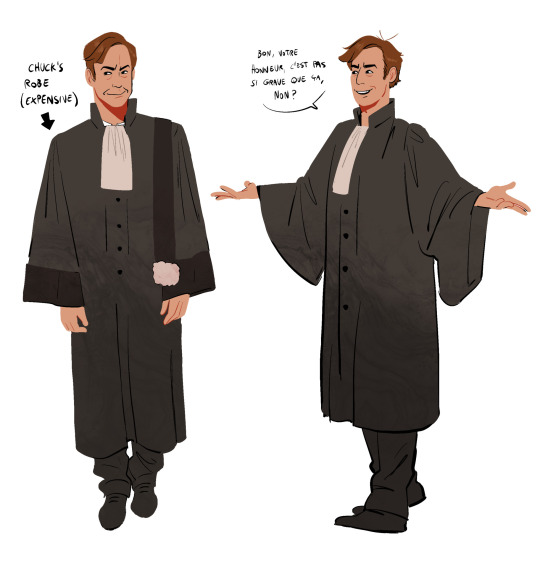
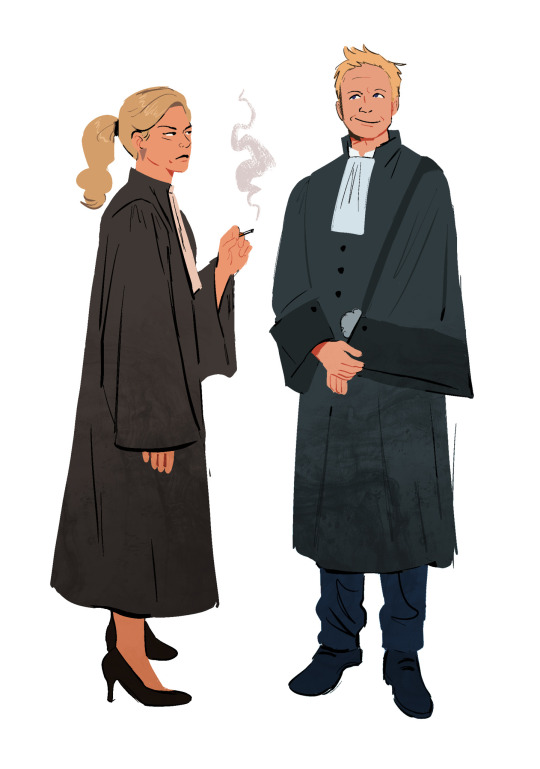
Thinking about better call saul if the action took place in france just because I wanted to see them in cunty robes lmao. More thoughts under the cut!
Obviously the action and the whole premise of bcs/brba wouldn't work in france (legal system aside, the whole cartel and walter white storyline would have to suffer major changes due to social security and the mexican cartel well. not existing here stricto sensu). But let's talk about the real Important Stuff : their names
I think Howard Hamlin would work well as Edouard Hamelin. He looses the cool HH initials yes, but it works really well as a genuine french name imo, and Howard/Edouard are pretty close phonetically
Chuck could still be called Charles without any realism issue, but he'd be nicknamed Charlie rather than Chuck because that's what a french person would go for... nicknames don't work the same, yeah
Kimberly Wexler and James McGill, I have no idea lmao. James when translated becomes Jacques, but it's such a boomerish uncool name that I cannot resolve myself to call my boy like that. It's also one generation too old. Jimmy being born in '60 could technically be called Jacques, but it'd be old-fashioned, as it's a name mostly given to the kids of the decade that came before him. McGill is an irish name, so something funny could be making Jimmy a breton with a funky last name like Gall/LeGall ? That's hilarious to me. But who knows.
Saul Goodman is a pun, so this is even harder for me to conceptualize. Saul's marketing would definitely not work in france at all, as no one would realistically hire a lawyer with a puny name and such chaotic displays (+ I think ads for legal démarchage are illegal mind you). However, let's have a crack at it. It would have to be a pun based off an expression similar to "it's all good man", or implying something positive and familiar... I need to think on that one.
#saul goodman#jimmy mcgill#howard hamlin#kim wexler#better call saul#bcs#breaking bad#brba#french au#my art#fanart#please help if you wanna participate to their naming...... im struggling as you can see#what i love about bcs is how deeply american it is but im just imagining this for fun lol. and also for the outfits#cause come on. any profession immediately becomes better with a Special Outfit involved#i should write about the robes too.... i have headcanons about the cast....#so much to say!!!!
1K notes
·
View notes
Text
But that’s the thing, I’m hooked on clades! If a Stink bug is a bug, and a starfish is a bug, then the last common ancestor of the stink bug and the starfish must be a bug. And that’s my ancestor! I’m a bug, Transcyberism! A big bug, with so many derived features that I don’t look buggy at all.
Similarly the octopus: legs, no spine, and an exoskeleton. An exoskeleton? Yes, a highly modified exoskeleton, currently in use as a beak. The beak of the squid is a homolog to the shell of the snail.
I think I did not stop being a bug when I grew a spine. Just like I didn’t stop being a tetrapod when I stood upright.
And as long as I’m calling myself a bug, how can I exclude this handsome young fellow?

Exoskeleton, check. It’s made of cellulose!
No spine at all, check.
Legs? It’s a stretch, but there is one flexible limb used for locomotion. So I’m counting it.
We have a bug! A single celled bug. Therefore, thinking with clades, all animals are bugs, even the coral polyp.
You can certainly argue that this convention makes “bug” a meaningless term. But I disagree. A bug is any living thing with a special place in my heart <3
#bug#see there is bug sensu stricto#ie only hemipterans#there’s bug sensu lato#ie insects and spiders and crustaceans and myriapods#and then there’s bug sensu lato lato#defined as anything I might tag as a bug on this blog
345 notes
·
View notes
Text
This whole post feels rather crass to me, I think it's correct but it's rather crass. It's using genocide as an argumentative cudgel to thwack mildly annoying people with, and that's a completely crass thing to do. If it makes me look bad that's probably fair.
At the core of 2010s identity politics was this idea, usually implicit, that persecution teaches empathy; that oppressed people acquired through their oppression some deeper understanding of the nature of oppression as such and were therefore (as identity groups, not as individuals) uniquely well positioned to imagine better systems for the future.
I've said this before, but I think that Israel's current genocide in Gaza is an almost maximally potent counterexample to this idea. Not that it ever made very much sense, but people could always mount a defense of the form "Well, we've never had a society ruled by [marginalized group], so saying that they would do all the same heinous shit as [dominant group] if they were in charge is totally unfounded! Here's a bunch of theory that says they wouldn't" and so on.
But, look. If you are a fan of 2010s identity politics, it should probably concern you that the ideological justification for Israel's existence as a nation state is really pretty similar in form (although obviously vastly different in scale and in specifics) to the justification given for various identity-based campus policies of the 2010s and so on (not safe spaces sensu stricto but their ilk). Now I don't want to equivocate here: I think the right's hysteria over safe spaces is stupid, because these sorts of campus policies don't really do very much other than make people feel excluded, or maybe get someone expelled for some dumb reason or whatever. That sucks but nobody dies. In general I think campus politics is massively overinflated in the public imagination, and even when extended beyond the college setting I think these sorts of policies generally fall into the "dumb, but not very important" category. But we're talking about the shape of an argument here, not the effect of a policy. And, yeah, the argument is shaped the same, and it's a bad argument: marginalized people need spaces in which they have local hegemony in order to protect themselves from oppressors on the outside, and they're justified in using this local hegemony in ways that may seem capricious or discriminatory because, hey, they as marginalized people know what they need to do to fight their own oppression.
Well, Israel says that Jews will only be safe if they have their own nation state, and they are justified in pursuing discriminatory and indeed now genocidal policies because, according to the Israeli state, that is what is necessary to preserve the Israeli state and protect Jews. And who is anyone else to argue with that?
121 notes
·
View notes
Note
Birds are class Aves.
Sure, under Linnaean taxonomy. But, well,
A) Linnaeus was a eugenecist so his scientific opinions are suspect and his morality is awful
B) he didn't know about evolution
C) he didn't know about prehistoric life
so his classification system? Sucks ass. It doesn't work anymore. It no longer reflects the diversity of life.
Instead, scientists - almost across the board, now - use Clades, or evolutionary relationships. No rankings, no hierarchies, just clades. It allows us to properly place prehistoric life, it removes our reliance on traits (which are almost always arbitrary) in classifying organisms, and allows us to communicate the history of life just by talking about their relationships.
So, for your own edification, here's the full classification of birds as we currently know it, from biggest to smallest:
Biota/Earth-Based Life
Archaeans
Proteoarchaeota
Asgardians (Eukaryomorphans)
Eukaryota (note: Proteobacteria were added to an asgardian Eukaryote to form mitochondria)
Amorphea
Obazoa
Opisthokonts
Holozoa
Filozoa
Choanozoa
Metazoa (Animals)
ParaHoxozoa (Hox genes show up)
Planulozoa
Bilateria (all bilateran animals)
Nephrozoa
Deuterostomia (Deuterostomes)
Chordata (Chordates)
Olfactores
Vertebrata (Vertebrates)
Gnathostomata (Jawed Vertebrates)
Eugnathostomata
Osteichthyes (Bony Vertebrates)
Sarcopterygii (Lobe-Finned Fish)
Rhipidistia
Tetrapodomorpha
Eotetrapodiformes
Elpistostegalia
Stegocephalia
Tetrapoda (Tetrapods)
Reptiliomorpha
Amniota (animals that lay amniotic eggs, or evolved from ones that did)
Sauropsida/Reptilia (reptiles sensu lato)
Eureptilia
Diapsida
Neodiapsida
Sauria (reptiles sensu stricto)
Archelosauria
Archosauromorpha
Crocopoda
Archosauriformes
Eucrocopoda
Crurotarsi
Archosauria
Avemetatarsalia (Bird-line Archosaurs, birds sensu lato)
Ornithodira (Appearance of feathers, warm bloodedness)
Dinosauromorpha
Dinosauriformes
Dracohors
Dinosauria (fully upright posture; All Dinosaurs)
Saurischia (bird like bones & lungs)
Eusaurischia
Theropoda (permanently bipedal group)
Neotheropoda
Averostra
Tetanurae
Orionides
Avetheropoda
Coelurosauria
Tyrannoraptora
Maniraptoromorpha
Neocoelurosauria
Maniraptoriformes (feathered wings on arms)
Maniraptora
Pennaraptora
Paraves (fully sized winges, probable flighted ancestor)
Avialae
Avebrevicauda
Pygostylia (bird tails)
Ornithothoraces
Euornithes (wing configuration like modern birds)
Ornithuromorpha
Ornithurae
Neornithes (modern birds, with fully modern bird beaks)
idk if this was a gotcha, trying to be helpful, or genuine confusion, but here you go.
all of this, ftr, is on wikipedia, and you could have looked it up yourself.
679 notes
·
View notes
Text
Last year, I wrote an essay discussing how the Law of Cycles could be considered an Uwasa (Rumor) by Magia Record lore logic, but it wasn't until my rewatch of the MR anime that I realized the same could also be said of Walpurgisnacht. We literally have a Rumor introducing her into the narrative at the end of S2x05, "I Won't Forgive Anyone"!
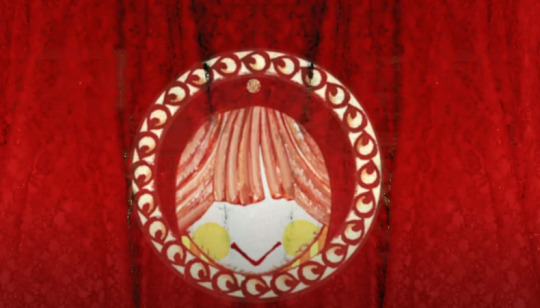
"Did you see it? Did you see her? The greatest, most terrible, the most powerful Witch of them all? If summoned by the power of the Uwasa, she would turn the land to ash and the skies to empty void, and civilization would cease to exist. That's what everyone in the Wings of Magius says! All hope will die on this day, and on this day a new hope will be born. Despair itself was created for this witch. For magical girls to change their fate!"
This "Rumor of Walpurgisnacht" not only succinctly introduces Walpurgisnacht to the narrative, it also provides an additional reason why Walpurgisnacht is coming to Kamihama in this iteration beyond the witch-luring macguffin the Wings of Magius are using to draw them in. In this sense, this Rumor is an MR-only addition that doesn't exist in the context of the original series.
For those not familiar with Magia Record, Rumors/Uwasa are witch-like entities created by Nemu Hiiragi's unique magic which obey certain rules in order to function. In that sense, Walpurgisnacht is definitely not an Uwasa sensu stricto, as her existence predates Nemu's.
However, just like the Law of Cycles--a promised savior which magical girls know about via rumors--Walpurgisnacht is also known through rumors well before she arrives in the narrative. In the original anime, Mami already knows this witch coming in the first timeline, and Touka and Nemu already know about her in this particular MR timeline as well. Stories about a massively destructive witch have been passed down from magical girl to magical girl over time... just like knowledge of the Uwasa are "transmitted" in Magia Record and just like the Law of Cycles at the end of the original anime.
In addition to setting up yet another parallel between Walpurgisnacht and the Law of Cycles, this would also explain why Walpurgisnacht does not appear to drop a grief seed when defeated by Madoka in earlier timelines (which leads directly to Homura being forced to kill her in a particularly traumatic iteration). (There is a grief seed in the PSP game, which is pre-Rebellion/Magia Record, but we'll see if that particular detail ends up being retconned out in Walpurgis no Kaiten.) Walpurgisnacht as an Uwasa-like being would explain why she acts and appears differently from other witches, despite ostensibly being a witch herself.
One other interesting thing about Uwasa is that they have the ability to "possess" magical girls--as seen with Tsuruno and Mami in Magia Record, and arguably Madoka in Rebellion. It is possible to forcibly separate the two after fusing, but only if the person attempting it truly understands the heart of the one who is possessed. It's easy to see how this could potentially be a key plot point in Walpurgis no Kaiten, with a tidy bit of symmetry--just as Homura wrested Madoka from the Law of Cycles, perhaps Madoka will return the favor in the future.
Rebellion also has other instances of proto-MR mechanics, such as Mami's use of Connect magic in her joint "Tiro Duet" attack with Madoka. It's not impossible there will be other carryovers from MR in Walpurgis no Kaiten, especially since Inu Curry was heavily involved in all three productions and has been extremely consistent with their symbolism thus far. This is just a tentative theory at the moment, but file this one under the "I am watching closely" tab.
67 notes
·
View notes
Text
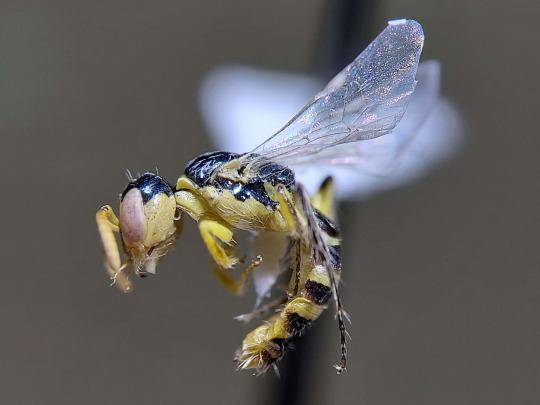
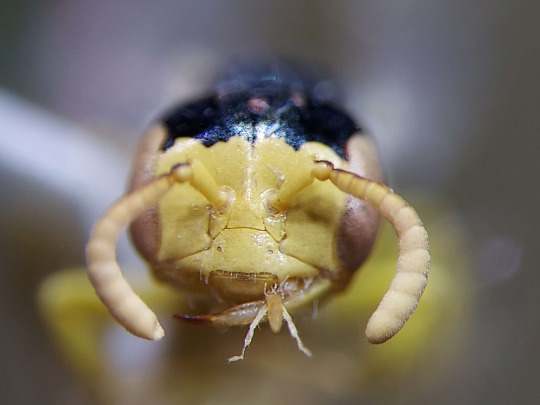

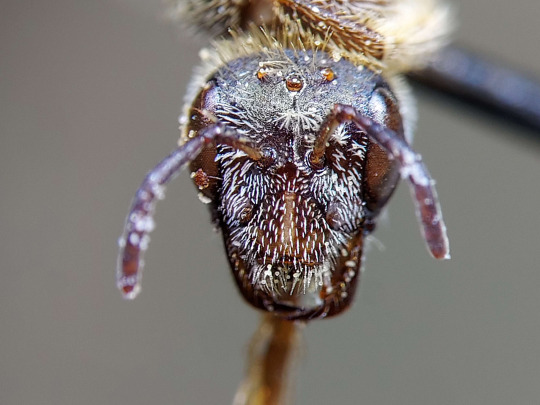
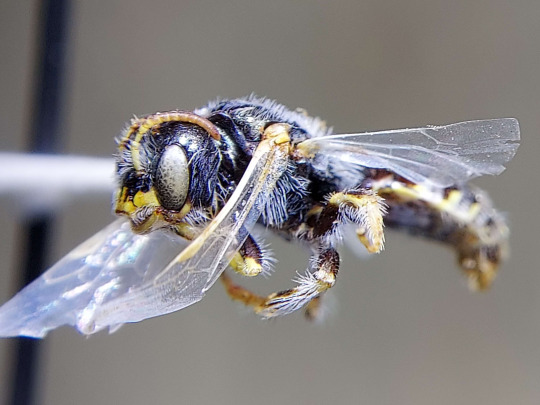
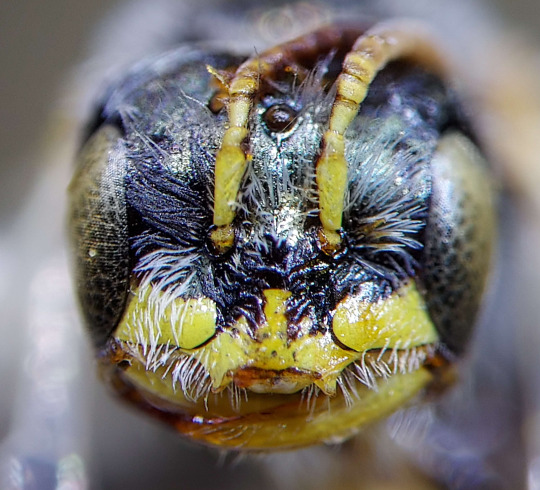
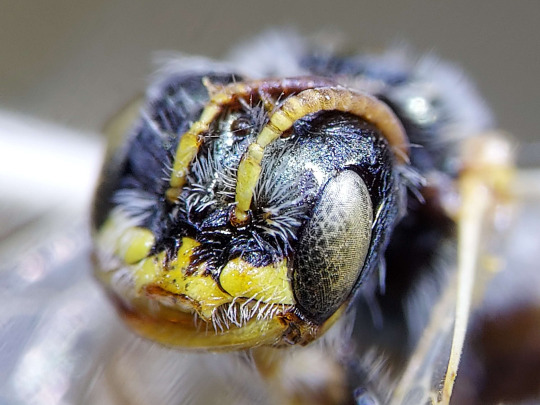
i started looking at some unidentified fairy bees (Perdita spp.) in my lab's collection today. this is the most diverse genus of bees in north america with over 550 described species in just the US. they're extremely tiny and extremely weird and extremely hard to ID.
the first one is probably a male of the monotypic subgenus Xeromacrotera and one of the few members of the genus to be awarded a common name, the Big-Headed Fairy Bee, Perdita cephalotes, which actually display a whole range of head sizes as you can see in this figure.
EDIT: nope i'm a dummy. the first one is actually something in the extremely tricky ventralis group in the Perdita sensu stricto subgenus.
bottom two are a female and male in the subgenus Cockerellia (named after Theodore "Mr Too Damn Many Bees" Cockerell), probably both at least closely related to the species Perdita albipennis.
66 notes
·
View notes
Text
What I think the English language is really lacking are proper diminutives and augmentatives. All you have is stuff like cat -> kitty or lord -> overlord. As a polish speaker, this sucks ass. Our diminutives and augmentatives are MUCH more expressive and y'all are really missing out. We can diminutivise words until they become nearly unintelligible. Example:
1. kot (cat)
2. kotek (kitty)
3. koteczek (smaller/cuter kitty)
4. koteczuniek (even more)
5. kotesiunieczek (holy shit)
Not only that, but we can also diminutivise adjectives, verbs, pronouns and adverbs. You can cuteify the adjective "cute"!
More linguistic yapping:
That is, because not only do we include the process of deminutiva sensu stricto, which is your average diminutive, but we also make use of hypocorisms (the process of pet-name-ification) in a much wider area of speech. The diminutive can also be used in a demeaning way and that is actually, factually a separate type of diminutive!
Not only that, but because of, yknow, the way language is used, often words which were already diminutives have replaced its root word in degree of usage, which led to NEW diminutives being created for these diminutives!
An example could be the word książka, as in book. It came from diminutivising the word księga, but soon the roles reversed and książka became the root word, with księga being treated as an augmentative. That meant, however, that książka still needed a further diminutive - that's how książeczka came to life.
I could write an entire article about it but I'll spare myself the work lol this is me exposing myself as a linguist
#linguistics#linguist humor#cunning linguist#philology#english language#the english language#grammar#english grammar#diminutive#augmentative#language#languages#learnlanguages#slavic#slavic languages#polish#polish language#slavic language#infodump#language learning#words words words#fruitful.txt
25 notes
·
View notes
Text
La part du Roi.
When I ask to the King who he is and why, he answers "my people". When I tell the King that I will return what belongs to him, he does not answer "thank you" but once again "my people". Long Live to the King !
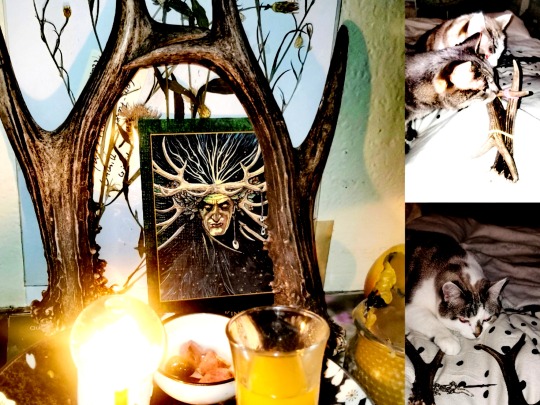
" What a hapiness this must have been 70 or 80 years ago and upwards, to those chosen few who had the good luck to be born (...) when the whole earth was so overrun with ghosts, boggles, bloody-bones, spirits, demons, ignis fatui, brownies, bugbears, black dogs, spectres, shellycoats, scarecrows, witches, wizards, barguests, Robin-Goodfellows, hags, night-bats, scrags, breaknecks, fantasms, hobgoblins, hobhoulards, boggy-boes, dobbies, hobthrusts, fetches, kelpies, warlocks, mocl-beggars, mum-pokers, Jemmy-burties, urchins, satyrs, pans, fauns, sirens, tritons, centaurs, calcars, nymphs, imps, incubusses, spoorns, men-in-the-oak, hell-wains, fire-drakes, kit-a-can-sticks, Tom-tumblers, mech-dicks, larrs, kitty-witches, hobbly-lanthorns, Dick-a-Tuesday, Elf-fires, Gylburnt-tails, knockers, elves, raw-heads, Meg-with-the-wads, old-shocks, ouphs, pad-foots, pixies, pictrees, giants, dwafs, Tom-pokers, tutgots, snapdragons, sprets, spunks, conjurers, thurses, spurns, tantarrabobos, swaithes, tints, tod-lowries, Jack-in-the-Wads, momos, changelings, redcaps, yeth-hounds, colt-pixies, Tom-thumbs, black-bugs, boggarts, scar-bugs, shag-foals, hodge-pochers, hob-thrushes, bugs, bull-beggars, bygorns, bolls, caddies, bomen, brags, wraithes, waffs, flay-boggarts, fiends, gallytrots, imps, gytrashes, patches, hob and lanthorns, gringes, boguests, bonelesses, Peg-powlers, pucks fays, kidnappers, gally-beggars, hydskins, nickers, madcapas, trolls robinets, friars ' lanthorns, silkies, cauld-lads, death-heearses, goblins, hob-headlesses, buggaboes, kows, or cowes, nickies, nacks, necks, waiths, miffies, buckies, gholes, sylphs, guests, swarths, freiths, freits, gy-carlins, pigmies, chittifaces, nixies, jinny-burnt-tails, dudmn, hell-hounds, dopple-gangers, boggleboes, bogies, redmen, portunes, grants, hobbits, hobgoblins, brown-men, cowies, dunnies, wirrikows, alholdes, mannikins, follets, korreds, lubberkins, cluricauns, kobolds, leprechauns, kors, mares, korreds, puckles, korigans, sylvans, succubuses, black-men, shadows, banshees, lianhanshees, clabbernappers, Gabriel-hounds, mawkins, doubles, corpse lights, scrats, mahounds, trows, gnomes, sprites, fates, fiends, sybils, nick-nevins, whitewomen, fairies, thrummy-caps, curties, and nisses, and apparitions of every shape, make, form, fashion, kind and description..."
-- Excerpt from K.M Briggs, who herself quotes an obscure folklorist in her Dictionary of Fa*ries. + merci mon ami @sensu-stricto encore une fois!!!
8 notes
·
View notes
Text
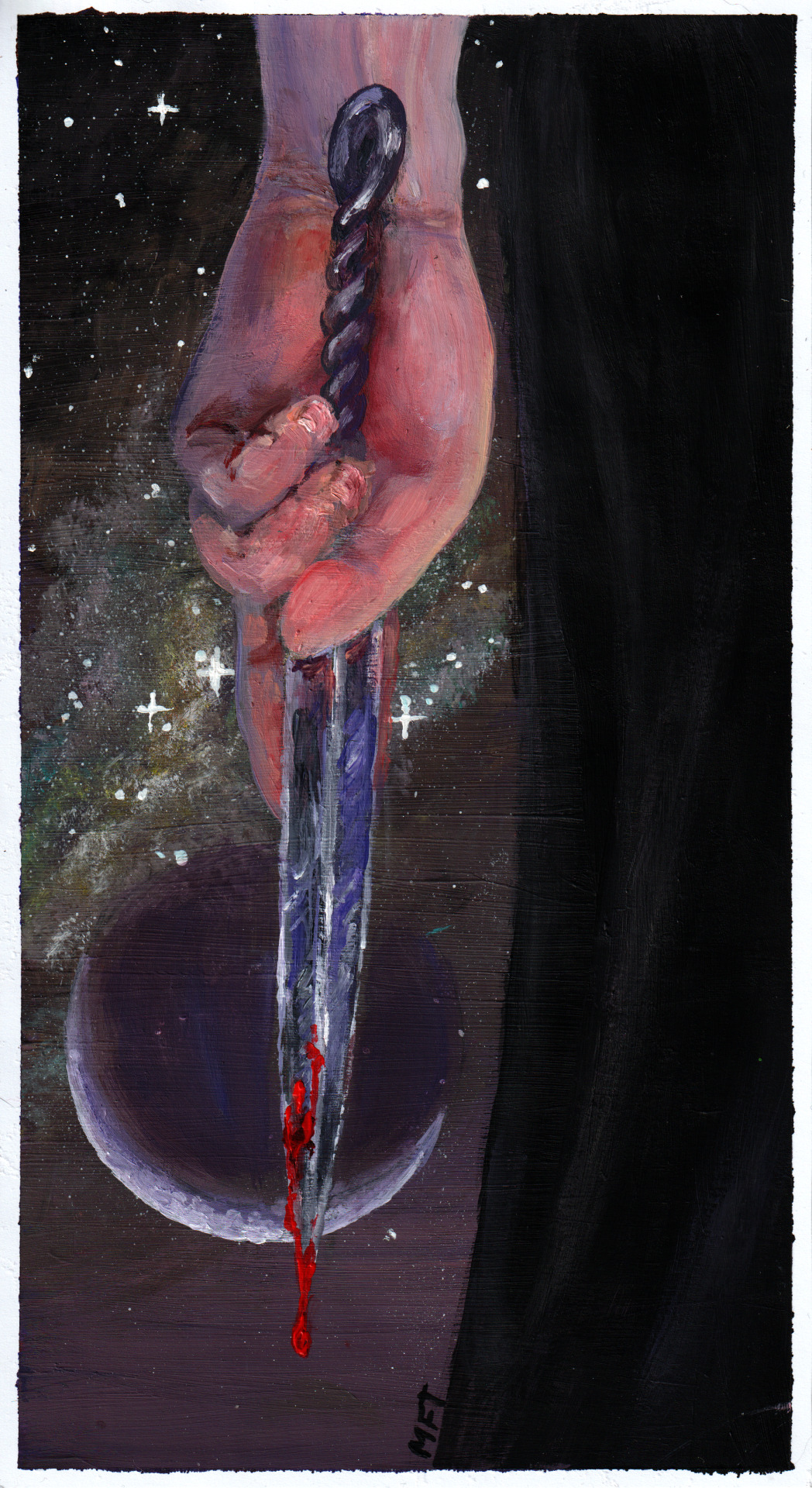
Greeting the Moon (originally: Holdköszöntés) 2024 Acrylic on paper
I missed acrylics. At last I feel well enough to paint again (knock on wood). There are so many things I want to paint, I have an absolute stack of sketches. But first of all I finished this, after all I had already started it before I didn't feel up to it for a while.
I realise that this is a strange way to hold a dagger and not a safe way to actually use it for the intended purpose, and that it has a handle for a reason. Still, when I hold one in order to gesture with it as opposed to actively slicing/piercing something with it right at that moment, I like holding it like this, two fingers lying along the flat of the blade, making it an extension of my arm; and for this picture it felt right.
#art#artists on tumblr#acrylicpainting#night sky#moonlight#moon#crescent moon#stars#blood#blade#hand#medea-typical death mysticism#sensu stricto
9 notes
·
View notes
Text
The Devil's legacy
People close to me know I've complained many times about how too much of Satanism is being tied to Christianity, how so many Satanists are merely living in Christianity's shadow. They're doing what has been done for centuries which is using Satan as a symbol of power to combat the institution or values they hate.
I sought to fix that issue at least within my practice and the future covenant I long to write however today I began to wonder if that was possible at all without divorcing key part of the Devil from his totality.
The history of the Devil a few centuries before the Church of Satan is an history of people; socialists, non-conformists, the oppressed, the desperate, revolutionaries, feminists, suffragettes & left wing thinkers using our Devil unique abilities to undermine the Christian hegemony & the status quo. That struggle never really stopped either, the biggest — I guess we'll call them Satanic — organization, The Satanic Temple, is still doing that today.
If you look into a more non denominational Devil in traditional Witchcraft which draws a lot of it's tradition & folklore from the witches persecution, the inquisitor writings on witches and of course the witches account of the Sabbat & their craft, we immediately run into the same issue where our Devil is intermingled just as strongly with Christianity.
Other issues is the nature of our Devil which inherently run contrary to Christianity. Of course many ideas and philosophies run contrary to the religion, that does not make them an adversary sensu stricto. However we are not merely philosophically opposed, we are spiritual foes in the clearest sense. Everything down to Witchcraft in itself is in direct opposition. Combine that with the fact that Christianity is the largest religion in the world and that a huge amount of Satanist are here in the first place due to religious trauma, perhaps completely divorcing Christianity from our Devil is a foolish quest. For now anyway.
There is this delusion shared by many that the struggle against Abrahamic religions is over, that it's now "cringe" or beating a dead horse to oppose them. I don't know how you can possibly be alive in this world, or see the news and believe this. Of course we'll never beat them in numbers. We will always be the minority. Our Devil in his great wisdom favors quality over quantity.
I'm not claiming the Craft should be about Christianity, it absolutely should not at all be. It was simply maybe an error on my part to want to erase that part of our Devil that ties him to it. It is a part of him and a shining part of our legacy. After all, without that side of him we would not be free.

26 notes
·
View notes
Text

Eastern North Pacific long-beaked common dolphin Delphinus bairdii bairdii
Observed by chezasaurus, CC BY-NC
A note ...or, brief essay on common dolphin taxonomy
The common dolphin Delphinus delphis sensu lato has a near-cosmopolitan distribution, and considerable variability exists across the globe. Multiple species of common dolphin have been named, but in general there has only been one species recognized. In 1994, a study of common dolphins focused predominantly on the Eastern North Pacific found that the global offshore short-beaked common dolphin Delphinus delphis sensu stricto is different from the long-beaked common dolphin Delphinus capensis found in disjunct coastal areas around the world. The extremely-long-beaked and usually rather-dull-patterned Indo-Pacific common dolphin Delphinus tropicalis occupied a position as either a third species or a distinctive regional form of long-beaked common dolphin.
More detailed genetic studies in the 2010s did not uphold the short-beaked v. long-beaked dichotomy, however. A more complex evolutionary story is revealed by genetics, indicating that the long-beaked morphology developed repeatedly and independently in distinct coastal areas; thus, classification of all the world's long-beaked common dolphins as Delphinus capensis is erroneous as they do not all relate to one another to the exclusion of short-beaked common dolphins. Once again, all common dolphins were a single species.
Not all marine mammalogists were satisfied with solution of recognizing a single polymorphic species with a cosmopolitan distribution, particularly with the regard to the rather well-studied long-beaked common dolphins found on the Pacific coast of the US and Mexico. Despite overlapping geographically with short-beaked common dolphins, these long-beaked dolphins are distinguishable by external appearance, skull characters, mitochondrial DNA, and - to at least some degree - ecology and life history. In addition to the long beak, the broad, dark stripe running from gape to anus along the lower sides of these dolphins and often darkening the side of the face (as seen above) is one of the most recognizable characters. In 2024, a redescription of these dolphins considered them a separate species, the Eastern Pacific long-beaked common dolphin Delphinus bairdii. That paper notes that the Eastern Pacific long-beaked common dolphins off South America, with a >2500km gap from their northern counterparts, may warrant separation as a distinct subspecies. Another genetic study published in 2024 suggests that long-beaked common dolphins in the Western North Pacific may also belong to this species. That is the course followed on this blog - while the exact nature of these dolphins is in need of further study, recognizing such disjunct forms as at least separate subspecies is essentially the standard in other cetacean species.
The days of two globally-distributed common dolphin species are behind us, but what of the other long-beaked common dolphins besides those of the Eastern Pacific? The recent paper revalidating Delphinus bairdii suggests, as others have, that the long-beaked forms remaining at present in Delphinus delphis likely warrant taxonomic distinction. The evidence suggests to me each long-beaked form of common dolphin is probably best regarded as its own independent species, separate from the global short-beaked common dolphin. As tempting as it is to make this the course followed on this blog, I think I shall have to split the difference for now, given that there is evidence that some long-beaked populations are not reciprocally monophyletic with regards to sympatric short-beaks. The lack of complete genetic isolation from short-beaked common dolphins is not necessarily an indicator that specific distinction is unwarranted, but could indicate recent and ongoing speciation, possibly in response to geologically-recent climatic upheavals related to Pleistocene glacial cycles (...plus dolphins are not shy about hybridization). Though I believe further study will probably bear out recognition of additional common dolphin species besides D. delphis sensu stricto and D. bairdii, for now I will be listing other long-beaked common dolphins on this blog as Delphinus "delphis" to indicate their questionable taxonomic assignment.
Recall that the inatungulates blog is NOT a definitive source for taxonomy, and while I base my (generally splittery) taxonomic opinions on information and proposals that are in the literature, I am not beholden to any single source on taxonomy and the opinions here should not be treated as authoritative; hopefully, however, I will prompt an appreciation for (the sometimes-overlooked minutiae of?) ungulate diversity, and send curious readers to investigate the literature to form their own opinions from the available data.
Ref:
Becker, MA, KR Murphy, FI Archer, TA Jefferson, LW Keith-Diagne, CW Potter, MF Urrutia-Osorio, I Ndong, and MR McGowen. 2024. Common dolphin (Delphinus delphis) mitochondrial genomes from Senegal reveal geographic structure across the North Atlantic but provide no support for a global long-beaked clade. Marine Mammal Science e13144.
Cunha, HA, RL de Castro, ER Secchi, EA Crespo, J Lailson-Brito, AF Azevedo, C Lazoski, and AM Solé-Cava. 2015. Molecular and morphological differentiation of common dolphins (Delphinus sp.) in the southwestern Atlantic: Testing the two species hypothesis in sympatry.
Heyning, JE, and WF Perrin. 1994. Evidence for two species of common dolphins (genus Delphinus) from the eastern North Pacific. Contributions in Science 442:1-35.
Jefferson, TA, and K Van Waerebeck. 2002. The taxonomic status of the nominal dolphin species Delphinus tropicalis Van Bree, 1971. Marine Mammal Science 18(4):787-818.
Jefferson, TA, FI Archer, and KM Robertson. 2024. The long-beaked common dolphin of the eastern Pacific Ocean: Taxonomic status and redescription of Delphinus bairdii. Marine Mammal Science e13133.
Segura-García, I, JP Gallo, S Chivers, R Díaz-Gamboa, and AR Hoelzel. 2016. Post-glacial habitat release and incipient speciation in the genus Delphinus. Heredity 117:400-407.
#Delphinus bairdii bairdii#Eastern North Pacific long-beaked common dolphin#Cetacea#Delphinidae#cetacean#dolphin#North America#United States#California#Pacific Ocean#keep reading#posting about taxonomy#that was a long one whoops
32 notes
·
View notes
Note
Mosses are small, non-vascular flowerless plantsin the taxonomic division Bryophyta(/braɪˈɒfətə/,[3] /ˌbraɪ.əˈfaɪtə/) sensu stricto. Bryophyta (sensu lato, Schimp. 1879[4]) may also refer to the parent group bryophytes, which comprise liverworts, mosses, and hornworts.[5]Mosses typically form dense green clumps or mats, often in damp or shady locations. The individual plants are usually composed of simple leaves that are generally only one cell thick, attached to a stem that may be branched or unbranched and has only a limited role in conducting water and nutrients. Although some species have conducting tissues, these are generally poorly developed and structurally different from similar tissue found in vascular plants.[6] Mosses do not have seeds and after fertilisation develop sporophytes with unbranched stalks topped with single capsules containing spores. They are typically 0.2–10 cm (0.1–3.9 in) tall, though some species are much larger. Dawsonia, the tallest moss in the world, can grow to 50 cm (20 in) in height. There are approximately 12,000 species.[2]Moss
Temporal range: Carboniferous[1]–present
PreꞒ
Ꞓ
O
S
D
C
P
T
J
K
Pg
NClumps of moss on the ground and base of trees in the Allegheny National Forest, Pennsylvania, United StatesScientific classificationKingdom:PlantaeClade:EmbryophytesClade:SetaphytaDivision:Bryophyta Schimp. sensu strictoClasses[2]
Takakiopsida
Sphagnopsida
Andreaeopsida
Andreaeobryopsida
Oedipodiopsida
Polytrichopsida
Tetraphidopsida
Bryopsida
Synonyms
Musci L.
Muscineae Bisch.
Mosses are commonly confused with liverworts, hornworts and lichens.[7] Although often described as non-vascular plants, many mosses have advanced vascular systems.[8][9] Like liverworts and hornworts, the haploidgametophyte generation of mosses is the dominant phase of the life cycle. This contrasts with the pattern in all vascular plants (seed plantsand pteridophytes), where the diploid sporophyte generation is dominant. Lichens may superficially resemble mosses, and sometimes have common names that include the word "moss" (e.g., "reindeer moss" or "Iceland moss"), but they are fungal symbioses and not related to mosses.[7]: 3
The main commercial significance of mosses is as the main constituent of peat (mostly the genus Sphagnum), although they are also used for decorative purposes, such as in gardens and in the florist trade. Traditional uses of mosses included as insulation and for the ability to absorb liquids up to 20 times their weight.
GUYS I FOUND BERDLY
167 notes
·
View notes
Text


I actually have more than one HxH rareship
Or not ships sensu stricto? Honestly, I just like to imagine characters interacting to see what would happen and, in whatever way it will develop, I'll be content.
Respectively they're "nerds dedicated to their collections to a quite excessive degree" and "proofs that the Hunter Association is a broken system"
#hxh#hunter x hunter#neon nostrade#milluki zoldyck#isaac netero#pariston hill#are there any names for those ships? i have no idea#i draw
38 notes
·
View notes